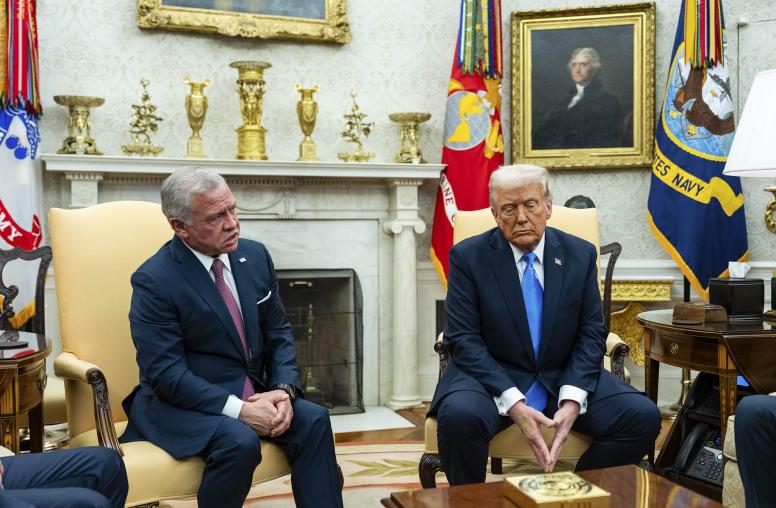Historic UAE-Israel Trade Deal Proves Abraham Accords' Resilience
While Israel’s ties with some Arab states continue to warm, Israeli-Palestinian diplomacy recedes from reach.
Nearly two years since the signing of the Abraham Accords — U.S.-brokered agreements normalizing Israeli relations with the UAE and Bahrain — the bilateral hope and promise encapsulated in that diplomatic achievement have borne fruit in several arenas. This is particularly the case between Israel and the UAE, underscored most recently by the Free Trade Agreement (FTA) signed between the two countries on May 31. Indeed, the agreement follows a steady pace of warming ties and joint endeavors since the two countries agreed to normalize relations in 2020.

Jerusalem Tensions Fail to Derail Normalization
This FTA is remarkable on its own terms — it will remove duties on most goods traded between the two nations and can thereby be expected to give a meaningful boost to trade and partnerships across a variety of sectors. As such, it serves as a reminder that contrary to much of the analysis of the Abraham Accords, these agreements are about far more than finding common security ground and assurance in the face of a shared Iranian threat. While Iran does serve as a mutual concern partly driving these new alignments, the cooperative economic, social and technological dividends already yielded by the accords tell us that for all concerned, normalization is as much a matter of creating opportunities as it is of warding off challenges.
As such, it is perhaps more remarkable that the FTA was signed in the immediate wake of flaring violence and tensions in Jerusalem, following a provocatively routed and conducted “Jerusalem Day” flag parade of extreme right-wing Jewish nationalists through a Palestinian neighborhood of the city, and a prior month of rising violence centered around growing challenges to the historic Status Quo arrangement on Haram Al Sharif/Temple Mount. In fact, the same day the FTA was signed, the UAE foreign ministry condemned the “storming of extremist settlers into the courtyard of the blessed al-Aqsa Mosque under the protection of the Israeli forces.” In this post-Arab Peace Initiative world, the message is clear: Jerusalem — specifically Al-Aqsa mosque — remains important to the Emiratis, but the future and fate of their burgeoning ties with Israel will not rise and fall solely on the trajectory of Israeli-Palestinian relations or the conflict and occupation. These agreements are resilient and beholden to national interests alone.
The Israeli-Palestinian Conflict Still Looms Over New Regional Alignments
This is a phenomenon with reverberations and reflections beyond the Emirates. In recent days, U.S. Secretary of State Tony Blinken has referred to Saudi Arabia as a “critical partner…[in] helping to expand the Abraham Accords.” This statement comes against a backdrop of proliferating reports and speculation about a recent senior level Israeli visitor to the Kingdom, and Biden administration efforts to work toward more formal normalizing of ties between those two countries, including through reported mediation of a Saudi-Egyptian-Israeli deal pertaining to the transfer of two Red Sea islands from Egyptian to Saudi sovereignty. If Saudi Arabia has continued to hold the formal line against normalizing ties with Israel absent progress toward a Palestinian state, their recognition that normalization is an end-goal to be sought is clear. In this vein, while at the Davos Economic Forum in recent days, Saudi Foreign Minister Prince Faisal Bin Farhan pushed back on speculation that his country’s position had changed. He did so while lauding the promise and potential that normalization could bring, but said, “we won’t be able to reap those benefits unless we address the issue of Palestine.” It is hard to imagine that Saudi Arabia does not have a clear eye on the potential scope of those benefits as it considers its Emirati neighbor’s target of increasing annual bilateral trade with Israel to more than $10 billion over the next five years.
As President Biden readies for a visit to Jerusalem and Ramallah at the end of this month, and a possible stop in Saudi Arabia, it is this heady brew of competing and at times conflicting priorities, realities and considerations that are confronting him. While the administration has continued to insist on “an enduring commitment to the principle of a two-state solution,” the lack of vigorous pursuit toward that goal, and perceived inaction or even backtracking on previous commitments, has done little to warm official U.S.-Palestinian ties or engender greater trust in the United States as a credible third party that can broker an end to the conflict and occupation. Meanwhile, with the United States facing the realities of rising oil prices amid Russia’s war on Ukraine, and the prospect of more realistic foreign policy progress on warming (if gradual) Saudi-Israeli ties, a focus on mending strained relations with the Saudi Kingdom and, in the process, pushing further toward Saudi-Israeli normalization seems like a lower hanging fruit than taking Israelis and Palestinians to task, or challenging them to renew diplomacy.



